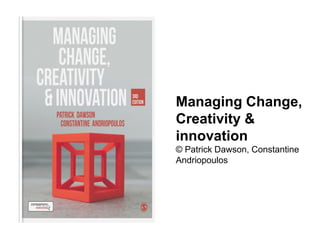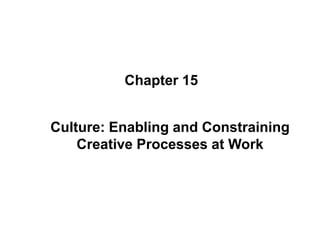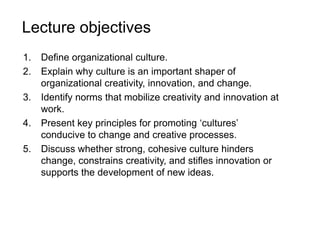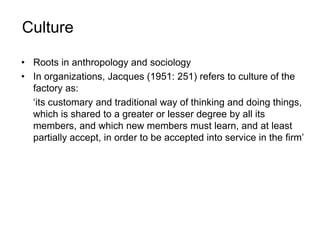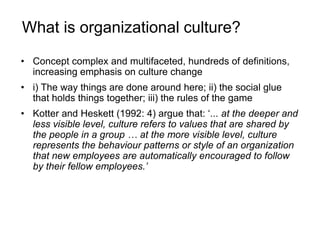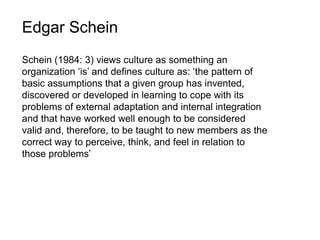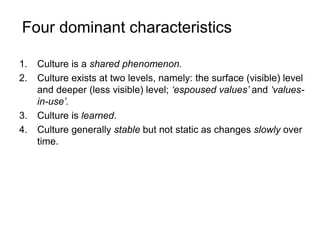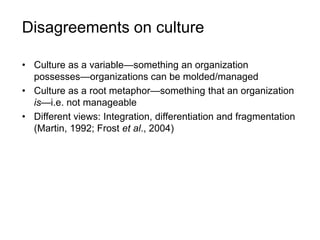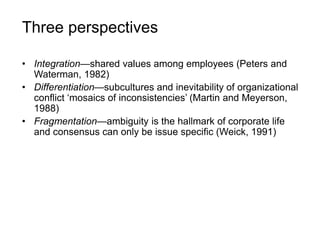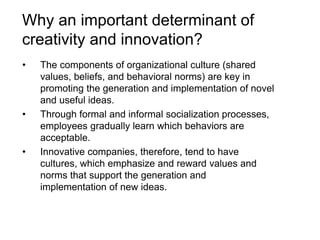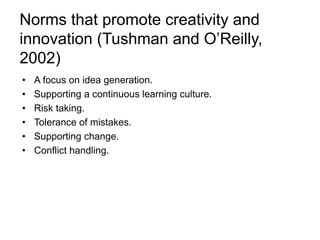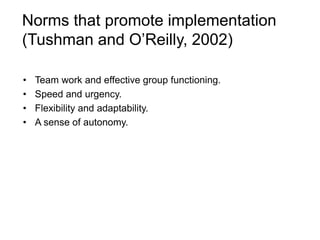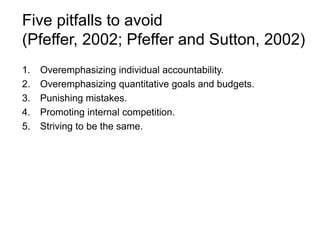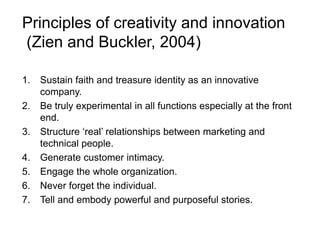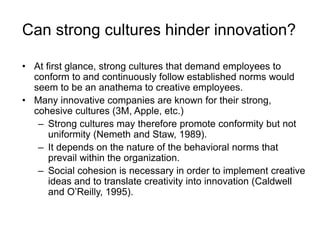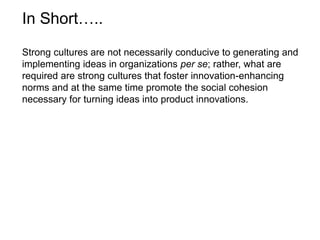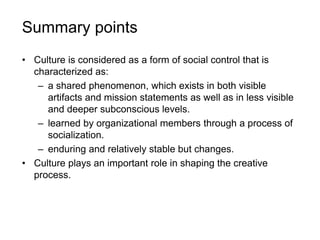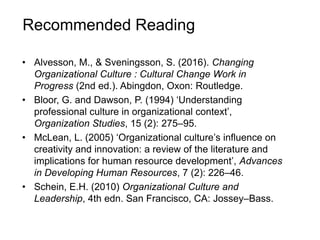4811370.pdf
- 1. Managing Change, Creativity & innovation ┬® Patrick Dawson, Constantine Andriopoulos
- 2. Culture: Enabling and Constraining Creative Processes at Work Chapter 15
- 3. Lecture objectives 1. Define organizational culture. 2. Explain why culture is an important shaper of organizational creativity, innovation, and change. 3. Identify norms that mobilize creativity and innovation at work. 4. Present key principles for promoting ÔÇÿculturesÔÇÖ conducive to change and creative processes. 5. Discuss whether strong, cohesive culture hinders change, constrains creativity, and stifles innovation or supports the development of new ideas.
- 4. Culture ÔÇó Roots in anthropology and sociology ÔÇó In organizations, Jacques (1951: 251) refers to culture of the factory as: ÔÇÿits customary and traditional way of thinking and doing things, which is shared to a greater or lesser degree by all its members, and which new members must learn, and at least partially accept, in order to be accepted into service in the firmÔÇÖ
- 5. What is organizational culture? ÔÇó Concept complex and multifaceted, hundreds of definitions, increasing emphasis on culture change ÔÇó i) The way things are done around here; ii) the social glue that holds things together; iii) the rules of the game ÔÇó Kotter and Heskett (1992: 4) argue that: ÔÇÿ... at the deeper and less visible level, culture refers to values that are shared by the people in a group ÔǪ at the more visible level, culture represents the behaviour patterns or style of an organization that new employees are automatically encouraged to follow by their fellow employees.ÔÇÖ
- 6. Edgar Schein Schein (1984: 3) views culture as something an organization ÔÇÿisÔÇÖ and defines culture as: ÔÇÿthe pattern of basic assumptions that a given group has invented, discovered or developed in learning to cope with its problems of external adaptation and internal integration and that have worked well enough to be considered valid and, therefore, to be taught to new members as the correct way to perceive, think, and feel in relation to those problemsÔÇÖ
- 7. Four dominant characteristics 1. Culture is a shared phenomenon. 2. Culture exists at two levels, namely: the surface (visible) level and deeper (less visible) level; ÔÇÿespoused valuesÔÇÖ and ÔÇÿvalues- in-useÔÇÖ. 3. Culture is learned. 4. Culture generally stable but not static as changes slowly over time.
- 8. Disagreements on culture ÔÇó Culture as a variableÔÇösomething an organization possessesÔÇöorganizations can be molded/managed ÔÇó Culture as a root metaphorÔÇösomething that an organization isÔÇöi.e. not manageable ÔÇó Different views: Integration, differentiation and fragmentation (Martin, 1992; Frost et al., 2004)
- 9. Three perspectives ÔÇó IntegrationÔÇöshared values among employees (Peters and Waterman, 1982) ÔÇó DifferentiationÔÇösubcultures and inevitability of organizational conflict ÔÇÿmosaics of inconsistenciesÔÇÖ (Martin and Meyerson, 1988) ÔÇó FragmentationÔÇöambiguity is the hallmark of corporate life and consensus can only be issue specific (Weick, 1991)
- 10. Why an important determinant of creativity and innovation? ÔÇó The components of organizational culture (shared values, beliefs, and behavioral norms) are key in promoting the generation and implementation of novel and useful ideas. ÔÇó Through formal and informal socialization processes, employees gradually learn which behaviors are acceptable. ÔÇó Innovative companies, therefore, tend to have cultures, which emphasize and reward values and norms that support the generation and implementation of new ideas.
- 11. Norms that promote creativity and innovation (Tushman and OÔÇÖReilly, 2002) ÔÇó A focus on idea generation. ÔÇó Supporting a continuous learning culture. ÔÇó Risk taking. ÔÇó Tolerance of mistakes. ÔÇó Supporting change. ÔÇó Conflict handling.
- 12. Norms that promote implementation (Tushman and OÔÇÖReilly, 2002) ÔÇó Team work and effective group functioning. ÔÇó Speed and urgency. ÔÇó Flexibility and adaptability. ÔÇó A sense of autonomy.
- 13. Five pitfalls to avoid (Pfeffer, 2002; Pfeffer and Sutton, 2002) 1. Overemphasizing individual accountability. 2. Overemphasizing quantitative goals and budgets. 3. Punishing mistakes. 4. Promoting internal competition. 5. Striving to be the same.
- 14. Principles of creativity and innovation (Zien and Buckler, 2004) 1. Sustain faith and treasure identity as an innovative company. 2. Be truly experimental in all functions especially at the front end. 3. Structure ÔÇÿrealÔÇÖ relationships between marketing and technical people. 4. Generate customer intimacy. 5. Engage the whole organization. 6. Never forget the individual. 7. Tell and embody powerful and purposeful stories.
- 15. Can strong cultures hinder innovation? ÔÇó At first glance, strong cultures that demand employees to conform to and continuously follow established norms would seem to be an anathema to creative employees. ÔÇó Many innovative companies are known for their strong, cohesive cultures (3M, Apple, etc.) ÔÇô Strong cultures may therefore promote conformity but not uniformity (Nemeth and Staw, 1989). ÔÇô It depends on the nature of the behavioral norms that prevail within the organization. ÔÇô Social cohesion is necessary in order to implement creative ideas and to translate creativity into innovation (Caldwell and OÔÇÖReilly, 1995).
- 16. Strong cultures are not necessarily conducive to generating and implementing ideas in organizations per se; rather, what are required are strong cultures that foster innovation-enhancing norms and at the same time promote the social cohesion necessary for turning ideas into product innovations. In Short..
- 17. Summary points ÔÇó Culture is considered as a form of social control that is characterized as: ÔÇô a shared phenomenon, which exists in both visible artifacts and mission statements as well as in less visible and deeper subconscious levels. ÔÇô learned by organizational members through a process of socialization. ÔÇô enduring and relatively stable but changes. ÔÇó Culture plays an important role in shaping the creative process.
- 18. Recommended Reading ÔÇó Alvesson, M., & Sveningsson, S. (2016). Changing Organizational Culture : Cultural Change Work in Progress (2nd ed.). Abingdon, Oxon: Routledge. ÔÇó Bloor, G. and Dawson, P. (1994) ÔÇÿUnderstanding professional culture in organizational contextÔÇÖ, Organization Studies, 15 (2): 275ÔÇô95. ÔÇó McLean, L. (2005) ÔÇÿOrganizational cultureÔÇÖs influence on creativity and innovation: a review of the literature and implications for human resource developmentÔÇÖ, Advances in Developing Human Resources, 7 (2): 226ÔÇô46. ÔÇó Schein, E.H. (2010) Organizational Culture and Leadership, 4th edn. San Francisco, CA: JosseyÔÇôBass.
